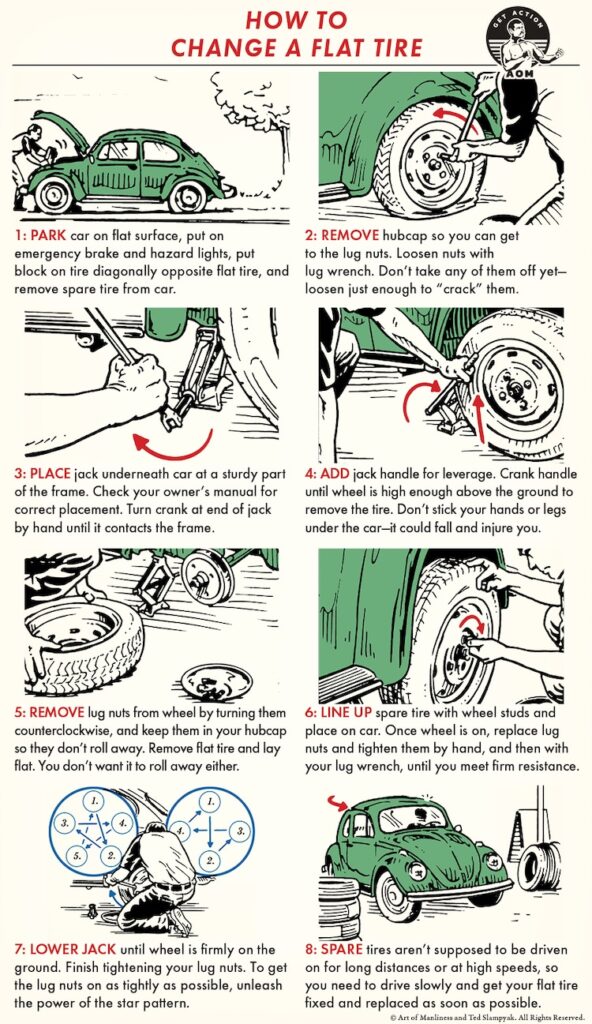Step-by-Step Tire Change Tips for Drivers
Here’s a complete guide on how to change a flat tire safely on the roadside. Every driver should know how to change a flat tire safely, because even if you have roadside assistance, it “never hurts to learn the proper way to change a tire, just in case.” Flats can happen anywhere, and knowing these steps will help you get back on the road quickly and—most importantly—safely.
“Park on firm, level ground, away from traffic. Turn on hazard lights and set the parking brake before you touch the tools.”
What You’ll Need Before You Start
Move to a safe area first: off the road, on firm, level ground, well away from traffic. Switch on hazard lights and apply the parking brake. Then gather your tools (most cars include these in the trunk under the floor panel):
- Spare tire: Properly inflated (full-size or “donut”).
- Jack: Use only the manufacturer’s jack point (see owner’s manual).
- Lug wrench (tire iron): For lug nuts.
- Optional but smart: Gloves, flashlight, wheel chocks/blocks, reflective triangle/flares, paper towel/wipes.

Step-by-Step: How to Change a Flat Tire
1) Pull Over Safely and Prepare the Car
Reduce speed gradually and pull far onto the shoulder or into a parking lot. Turn on hazards. Set the parking brake. Have passengers exit on the side away from traffic and wait in a safe spot. Place wheel chocks behind the opposite wheel(s) to prevent rolling.
Safety note: If the shoulder is narrow, traffic is fast, visibility is poor, or weather is severe, call roadside assistance. Your safety comes first.
2) Gather Your Tools and Spare
Retrieve the spare, jack, and lug wrench from their storage area (often under the trunk floor). If lighting is low, use a flashlight. Gloves help with grip and cleanliness.
3) Loosen the Lug Nuts (Before Jacking Up)
Remove any hubcap/wheel cover. With the wheel still on the ground, fit the wrench squarely and turn each lug nut counterclockwise about ¼–½ turn. Do not remove them yet. This prevents the wheel from spinning and keeps the car stable.
Common mistake: Don’t jack up first—you’ll fight a spinning wheel and risk knocking the car off the jack.
4) Jack Up the Car
Locate the correct jack point closest to the flat (a reinforced pinch weld/notch). Place the jack on solid, level ground; ensure it’s vertical. Raise the vehicle until the flat tire clears the ground by ~5–6 inches.
Never put any part of your body under a raised vehicle. As a backup, you can slide the removed flat under the sill (not as a substitute for a stand, but as a safety buffer).
5) Remove the Lug Nuts and Flat Tire
Finish removing the loosened lug nuts; keep them in a safe place (inside a hubcap or pocket). Pull the flat tire straight off the hub. Set it flat on the ground so it doesn’t roll away.
6) Mount the Spare Tire
Align the wheel holes with the lug bolts and push the spare fully onto the hub until flush. Thread each lug nut by hand first to avoid cross-threading. Finger-tighten in a crisscross pattern.
7) Partially Tighten the Lug Nuts (Star Pattern)
With the car still raised slightly, snug each nut with the wrench in a star/crisscross sequence (skip one nut each time). Make them moderately tight—not final torque yet.
8) Lower the Car and Fully Tighten Lug Nuts
Lower the car until the tire just touches and doesn’t spin, then tighten each lug firmly in the same star pattern so the wheel seats evenly. Lower fully and remove the jack. Give each lug a final firm pull in sequence.
Pro tip: If you have a torque wrench, tighten to your vehicle’s specified torque (see owner’s manual). Re-check torque after 50–100 km (30–60 miles).
9) Clean Up and Store Equipment
Put the flat tire in your trunk for repair/replacement. Stow the jack, wrench, and any covers. Ensure nothing is left on the roadside.
10) Drive Carefully and Fix the Flat Soon
Check the spare’s pressure if possible. Donut spares are temporary—typically limited to about 50 miles (80 km) and ~55 mph (90 km/h). Use the spare only to reach a service center, then repair or replace the damaged tire and restore your full set.
Quick Reference Checklist – How to Change a Flat Tire
- Hazards on, parking brake set, chock opposite wheel.
- Loosen lugs on ground → jack at correct point → raise.
- Remove flat → mount spare → hand-start lugs.
- Snug lugs in star pattern → lower to bite → tighten fully in star.
- Stow tools and flat; drive gently; repair/replace ASAP.
Safety & Practical Tips
- Manual first: Always follow your vehicle’s owner’s manual for jack points, torque specs, spare type, and TPMS notes.
- Run-flats/repair kits: Some cars have run-flat tires or sealant/air kits instead of a spare. Procedures differ—check the manual.
- Wheel locks: If you have locking lugs, keep the key in the glove box/trunk toolkit.
- Visibility: Use reflective triangles/flares at a safe distance behind the car; wear a reflective vest at night/low light.
- Surface matters: Avoid soft ground, gravel, or slopes. If unavoidable, call for assistance.
Mini-FAQ
Where exactly do I place the jack?
At the manufacturer-marked jack point near the flat tire (reinforced pinch weld or frame pad). Using the wrong spot can damage the car or slip the jack.
Do I need a torque wrench?
It’s best practice. If you don’t have one, tighten firmly in a star pattern now and ask a shop to torque the lugs properly; re-check after 30–60 miles.
What if my car has no spare?
Use the inflator/sealant kit per the manual or call roadside assistance. Many modern cars delete the spare to save weight/space.
My TPMS light is on after installing the spare—normal?
Yes. Donut spares often lack sensors; the TPMS may stay lit until the original wheel is repaired and reinstalled.
Can I rotate the donut into my regular tire set?
No. Donuts are temporary-use spares only; they’re not part of regular rotation.
What is the easiest way to change a flat tire by yourself?
The easiest way to change a flat tire is to follow a step-by-step process: pull over safely, switch on hazard lights, set the parking brake, loosen the lug nuts, jack up the car, remove the flat tire, mount the spare, and tighten the lug nuts in a star pattern. Practicing these steps ensures you know how to change a flat tire safely anytime.
